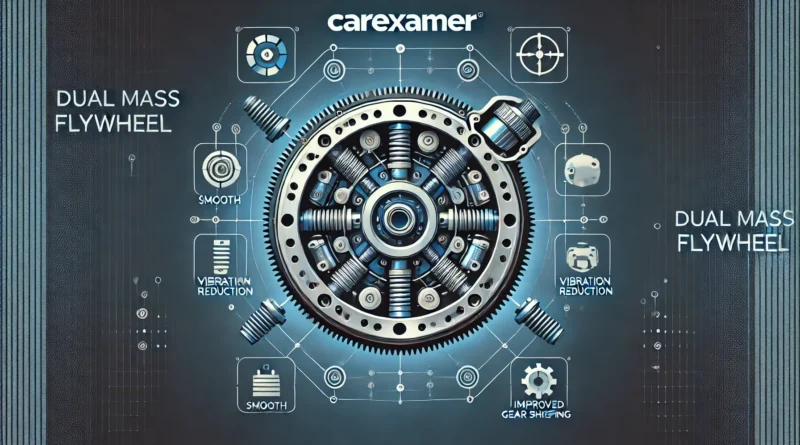A Guide What is a Dual Mass Flywheel (DMF)?
This guide will explain what is dual mass flywheel (DMF), how it works, its advantages, common issues, and what to consider if it needs replacement. When it comes to modern automotive engineering, the dual mass flywheel (DMF) plays a critical role in enhancing the driving experience, particularly in vehicles with manual transmissions. While the concept might sound technical, understanding what a DMF is and its function can be valuable for car owners, especially those experiencing clutch-related issues.
What is a Dual Mass Flywheel (DMF)?
A dual mass flywheel (DMF) is a type of flywheel used in modern vehicles, primarily in cars with manual transmissions, though some automatic transmissions use them as well. Unlike a traditional solid flywheel, a DMF is composed of two separate flywheels connected by a series of springs and dampers. The primary purpose of the DMF is to absorb and dampen vibrations from the engine, making the driving experience smoother and quieter.
How Does a Dual Mass Flywheel Work?
The DMF operates by dividing the flywheel’s mass into two distinct parts:
- Primary Flywheel: This part is attached to the crankshaft of the engine and rotates with it. The primary flywheel is responsible for transmitting engine power to the clutch.
- Secondary Flywheel: The secondary flywheel is connected to the transmission input shaft. This part receives the rotational energy from the primary flywheel through the springs and dampers.
Between these two flywheels, a set of springs and damping mechanisms work to absorb and reduce the torsional vibrations that occur as the engine operates. These vibrations are especially prominent at low engine speeds and during gear changes. By reducing these vibrations, the DMF helps to:
- Improve driving comfort by reducing cabin noise and vibrations.
- Protect the transmission and drivetrain components from excessive stress.
- Enhance overall driving smoothness, particularly in stop-and-go traffic or during gear shifts.
Advantages of a Dual Mass Flywheel
The dual mass flywheel offers several benefits over a traditional single mass flywheel:
- Smoother Operation: The DMF significantly reduces vibrations and noise, resulting in a smoother and more comfortable driving experience.
- Improved Gear Shifting: By damping the torsional vibrations, the DMF makes gear shifts smoother and more precise, which can be particularly noticeable in manual transmissions.
- Reduced Wear on Transmission Components: The DMF helps to protect the transmission and drivetrain components by absorbing the shock and stress that would otherwise be transmitted directly through the drivetrain. This can lead to longer component life and reduced maintenance costs.
- Enhanced Fuel Efficiency: By allowing the engine to run more smoothly, the DMF can contribute to better fuel efficiency, as the engine doesn’t have to work as hard to overcome vibrations.
Common Issues with Dual Mass Flywheels
While the DMF offers several advantages, it is also more complex than a traditional single mass flywheel, and this complexity can lead to potential issues:
- Wear and Tear: Over time, the springs and damping components within the DMF can wear out. This wear can lead to increased vibrations, noise, and even clutch slippage.
- Cost: DMFs are generally more expensive to replace than single mass flywheels due to their complexity and the materials used. Additionally, replacing a DMF often involves more labor, increasing the overall repair cost.
- Failure Symptoms: Common symptoms of a failing DMF include unusual noises (such as rattling or knocking) from the clutch area, increased vibrations through the clutch pedal or cabin, difficulty in shifting gears, and, in severe cases, clutch slippage or failure.
- Not Suitable for All Driving Styles: Vehicles subjected to aggressive driving, high performance tuning, or frequent towing may experience accelerated wear on the DMF, leading to earlier-than-expected failure.
Should You Replace a Failing DMF?
If your DMF shows signs of failure, it’s crucial to address the issue promptly. Ignoring a failing DMF can lead to more severe damage to the transmission, clutch, and other drivetrain components, resulting in higher repair costs.
When replacing a DMF, you typically have two options:
- Replace with a New DMF: This is the most straightforward option and ensures that your vehicle retains the smooth driving characteristics provided by the original DMF. However, it is also the more expensive option.
- Convert to a Single Mass Flywheel: Some car owners choose to replace the DMF with a single mass flywheel (SMF). This conversion can be more cost-effective and is often more durable, especially in high-performance applications. However, converting to an SMF can lead to increased vibrations and noise, which may affect driving comfort.
Before deciding, it’s essential to consult with a professional mechanic who can assess the condition of your DMF and provide advice based on your vehicle’s specific needs and your driving habits.
The dual mass flywheel is a sophisticated component that plays a crucial role in modern vehicles by improving driving comfort, reducing noise and vibrations, and protecting the transmission. While it offers several advantages, the DMF can be prone to wear and tear, leading to potential issues that require attention. Understanding the function and potential problems associated with a DMF can help you make informed decisions about maintenance and repairs, ensuring that your vehicle continues to perform smoothly and reliably. If you suspect an issue with your DMF, consult with a trusted mechanic to explore your options and keep your car in optimal condition.
Buying a used VW. Buying used vauxhall, BMW, Jaguar, Ford, Volvo, Range rover, Bentley, Aston Martin, Porsche, Ferrari, Lamborghini, Maserati, Hyundai, Tesla, Honda, Pagani

